Grid-Characteristic Method on Overlapping Curvilinear Meshes for Modeling Elastic Waves Scattering on Geological Fractures
Abstract
1. Introduction
2. Computational Method
2.1. Mathematical Statement
2.2. Grid-Characteristic Method on Structured Curvilinear Meshes
2.3. Computational Algorithm
- 1.
- Values from the background grid are copied in two layers of nodes placed along the vertical boundaries of the curvilinear grids and surrounding fractures. Section 4 describes in detail the features of constructing these curvilinear grids in the proposed modification of the computational method, which makes it possible to carry out this copying and, at the same time, obtain high accuracy of calculations.
- 2.
- Calculations are carried out in the direction OX in the background grid by the grid-characteristic method on Cartesian grids, described in [22].
- 3.
- Calculations are also performed for the OX direction in each curvilinear meshes surrounding the fractures using the grid-characteristic method on structured curvilinear meshes described in the next section.
- 4.
- Values from two layers of nodes of curvilinear grids placed along the vertical boundaries are copied in the congruent position nodes of the background grid.
3. Features of Curvilinear Computational Meshes
| Pseudocode |
|
4. Testing
5. Results of Numerical Experiments
5.1. Example #1
5.2. Example #2
5.3. Example #3
5.4. Example #4
5.5. Example #5
6. Conclusions
Author Contributions
Funding
Acknowledgments
Conflicts of Interest
References
- Feng, M.; Liu, T.; Lin, T.; Liu, X.; Li, N.; Xi, A. Fracture fillings and implication of fluid activities in volcanic rocks: Dixi Area in Kelameili Gas Field, Junggar Basin, Northwestern China. Minerals 2019, 9, 154. [Google Scholar] [CrossRef]
- Parry, W.T. Fault-fluid compositions from fluid-inclusion observations and solubilities of fracture-sealing minerals. Tectonophysics 1998, 290, 1–26. [Google Scholar] [CrossRef]
- Zheng, Y.; Liu, Y.; Xu, T.; Li, Z. Elastic Correlative Least-Squares Reverse Time Migration Based on Wave Mode Decomposition. Processes 2022, 10, 288. [Google Scholar] [CrossRef]
- Zhang, F.; Zhang, P.; Xu, Z.; Gong, X.; Han, L. Multisource Seismic Full Waveform Inversion of Metal Ore Bodies. Minerals 2021, 12, 4. [Google Scholar] [CrossRef]
- Schoenberg, M. Elastic wave behavior across linear slip interfaces. J. Acoust. Soc. Am. 1980, 68, 1516–1521. [Google Scholar] [CrossRef]
- Hsu, C.-J.; Schoenberg, M. Elastic waves through a simulated fractured medium. Geophysics 1993, 58, 964–977. [Google Scholar] [CrossRef]
- Pyrak-Nolte, L.J.; Myer, L.R.; Cook, N.G.W. Anisotropy in seismic velocities and amplitudes from multiple parallel fractures. J. Geophys. Res. 1990, 95, 11345–11358. [Google Scholar] [CrossRef]
- Backus, G.E. Long-wave elastic anisotropy produced by horizontal layering. J. Geophys. Res. 1962, 67, 4427–4440. [Google Scholar] [CrossRef]
- Zhang, J. Elastic wave modeling in fractured media with an explicit approach. Geophysics 2005, 70, T75–T85. [Google Scholar] [CrossRef]
- Zhang, J.; Gao, H. Elastic wave modelling in 3-D fractured media: An explicit approach. Geophys. J. Int. 2009, 177, 1233–1241. [Google Scholar] [CrossRef]
- Lan, H.Q.; Zhang, Z.J. Seismic wavefield modeling in media with fluid-filled fractures and surface topography. Appl. Geophys. 2012, 9, 301–312. [Google Scholar] [CrossRef]
- Favorskaya, A.V.; Zhdanov, M.S.; Khokhlov, N.I.; Petrov, I.B. Modelling the wave phenomena in acoustic and elastic media with sharp variations of physical properties using the grid-characteristic method. Geophys. Prospect. 2018, 66, 1485–1502. [Google Scholar] [CrossRef]
- Cui, X.; Lines, L.R.; Krebes, E.S. Seismic modelling for geological fractures. Geophys. Prospect. 2017, 66, 157–168. [Google Scholar] [CrossRef]
- Chen, T.; Fehler, M.; Fang, X.; Shang, X.; Burns, D. SH wave scattering from 2-D fractures using boundary element method with linear slip boundary condition. Geophys. J. Int. 2012, 188, 371–380. [Google Scholar] [CrossRef]
- Guo, J.; Shuai, D.; Wei, J.; Ding, P.; Gurevich, B. P-wave dispersion and attenuation due to scattering by aligned fluid saturated fractures with finite thickness: Theory and experiment. Geophys. J. Int. 2018, 215, 2114–2133. [Google Scholar] [CrossRef]
- Leviant, V.; Marmalevsky, N.; Kvasov, I.; Stognii, P.; Petrov, I. Numerical modeling of seismic responses from fractured reservoirs in 4D monitoring. Part one: Seismic responses from fractured reservoirs in carbonate and shale formations. Geophysics 2021, 86, 1ND-Z3. [Google Scholar] [CrossRef]
- Khokhlov, N.; Stognii, P. Novel Approach to Modeling the Seismic Waves in the Areas with Complex Fractured Geological Structures. Minerals 2020, 10, 122. [Google Scholar] [CrossRef]
- Novikov, M.A.; Lisitsa, V.V.; Kozyaev, A.A. Numerical modeling of wave processes in fractured porous fluid-saturated media. Numer. Methods Program. 2018, 19, 130–149. [Google Scholar]
- Fang, J.; Chen, H.; Zhou, H.; Rao, Y.; Sun, P.; Zhang, J. Elastic full-waveform inversion based on GPU accelerated temporal fourth-order finite-difference approximation. Comput. Geosci. 2020, 135, 104381. [Google Scholar] [CrossRef]
- Jaimes-Osorio, L.E.; Malcolm, A.; Zheglova, P.; Koene, E.F.; Thomsen, H.R. Reduced memory implementation of a local elastic finite-difference solver. Geophysics 2021, 86, F25–F33. [Google Scholar] [CrossRef]
- Slawinski, R.A.; Krebes, E.S. Finite-difference modeling of SH-wave propagation in nonwelded contact media. Geophysics 2002, 67, 1656–1663. [Google Scholar] [CrossRef]
- Khokhlov, N.; Favorskaya, A.; Stetsyuk, V.; Mitskovets, I. Grid-characteristic method using Chimera meshes for simulation of elastic waves scattering on geological fractured zones. J. Comput. Phys. 2021, 446, 110637. [Google Scholar] [CrossRef]
- Kvasov, I.; Petrov, I. Numerical Modeling of Seismic Responses from Fractured Reservoirs by the Grid-Characteristic Method; Society of Exploration Geophysicists: Houston, TX, USA, 2019. [Google Scholar]
- Wang, K.; Peng, S.; Lu, Y.; Cui, X. The velocity-stress finite-difference method with a rotated staggered grid applied to seismic wave propagation in a fractured medium. Geophysics 2020, 85, T89–T100. [Google Scholar] [CrossRef]
- Zou, Q.; Huang, J.P.; Yong, P.; Li, Z.C. 3D elastic waveform modeling with an optimized equivalent staggered-grid finite-difference method. Pet. Sci. 2020, 17, 967–989. [Google Scholar] [CrossRef]
- Du, Q.; Ba, J.; Han, D.; Sun, P.; Zhang, J. A staggered-grid lowrank finite-difference method for elastic wave extrapolation. Ann. Geophys. 2020, 63, 329. [Google Scholar] [CrossRef]
- Solano, C.P.; Donno, D.; Chauris, H. Finite-difference strategy for elastic wave modelling on curved staggered grids. Comput. Geosci. 2016, 20, 245–264. [Google Scholar] [CrossRef]
- Chung, E.T.; Efendiev, Y.; Gibson, R.L.; Vasilyeva, M. A generalized multiscale finite element method for elastic wave propagation in fractured media. GEM-Int. J. Geomath. 2016, 7, 163–182. [Google Scholar] [CrossRef]
- Huang, M.; Sha, G.; Huthwaite, P.; Rokhlin, S.I.; Lowe, M.J.S. Maximizing the accuracy of finite element simulation of elastic wave propagation in polycrystals. J. Acoust. Soc. Am. 2020, 148, 1890–1910. [Google Scholar] [CrossRef] [PubMed]
- Sticko, S.; Ludvigsson, G.; Kreiss, G. High-order cut finite elements for the elastic wave equation. Adv. Comput. Math. 2020, 46, 1–28. [Google Scholar] [CrossRef]
- Vamaraju, J.; Sen, M.K.; De Basabe, J.; Wheeler, M. Enriched Galerkin finite element approximation for elastic wave propagation in fractured media. J. Comput. Phys. 2018, 372, 726–747. [Google Scholar] [CrossRef]
- Cho, Y.; Gibson, R.L.; Lee, J.; Shin, C. Linear-slip discrete fracture network model and multiscale seismic wave simulation. J. Appl. Geophys. 2019, 164, 140–152. [Google Scholar] [CrossRef]
- Li, J.; Khodaei, Z.S.; Aliabadi, M.H. Spectral BEM for the analysis of wave propagation and fracture mechanics. J. Multiscale Model. 2017, 8, 1740007. [Google Scholar] [CrossRef]
- Hou, X.; Liu, N.; Chen, K.; Zhuang, M.; Liu, Q.H. The Efficient Hybrid Mixed Spectral Element Method With Surface Current Boundary Condition for Modeling 2.5-D Fractures and Faults. IEEE Access 2020, 8, 135339–135346. [Google Scholar] [CrossRef]
- Ponomarenko, R.; Sabitov, D.; Charara, M. Spectral element simulation of elastic wave propagation through fractures using linear slip model: Microfracture detection for CO2 storage. Geophys. J. Int. 2020, 223, 1794–1804. [Google Scholar] [CrossRef]
- Liu, J.; Kausel, E.; Liu, X.W. Using pseudo-spectral method on curved grids for SH-wave modeling of irregular free-surface. J. Appl. Geophys. 2017, 140, 42–51. [Google Scholar] [CrossRef]
- Mollhoff, M.; Bean, C.J. Validation of elastic wave measurements of rock fracture compliance using numerical discrete particle simulations. Geophys. Prospect. 2009, 57, 883–895. [Google Scholar] [CrossRef]
- Charara, M.; Sabitov, D. Spectral Element Method with curvilinear mesh for complex borehole acoustic modeling. In SEG Technical Program Expanded Abstracts; Society of Exploration Geophysicists: Houston, TX, USA, 2018; pp. 704–708. [Google Scholar]
- Cho, Y.; Gibson, R.L.; Vasilyeva, M.; Efendiev, Y. Generalized multiscale finite elements for simulation of elastic-wave propagation in fractured media. Geophysics 2018, 83, WA9–WA20. [Google Scholar] [CrossRef]
- De Basabe, J.D.; Sen, M.K.; Wheeler, M.F. Elastic wave propagation in fractured media using the discontinuous Galerkin method. Geophysics 2016, 81, T163–T174. [Google Scholar] [CrossRef]
- Bosma, S.; Hajibeygi, H.; Tene, M.; Tchelepi, H.A. Multiscale finite volume method for discrete fracture modeling on unstructured grids (MS-DFM). J. Comput. Phys. 2017, 351, 145–164. [Google Scholar] [CrossRef]
- Vasilyeva, M.; De Basabe, J.D.; Efendiev, Y.; Gibson, R.L., Jr. Multiscale model reduction of the wave propagation problem in viscoelastic fractured media. Geophys. J. Int. 2019, 217, 558–571. [Google Scholar] [CrossRef]
- Franceschini, A.; Ferronato, M.; Janna, C.; Teatini, P. A novel Lagrangian approach for the stable numerical simulation of fault and fracture mechanics. J. Comput. Phys. 2016, 314, 503–521. [Google Scholar] [CrossRef]
- Lisitsa, V.; Tcheverda, V.; Botter, C. Combination of the discontinuous Galerkin method with finite differences for simulation of seismic wave propagation. J. Comput. Phys. 2016, 311, 142–157. [Google Scholar] [CrossRef]
- Storti, B.; Garelli, L.; Storti, M.; D’Elía, J. A matrix-free Chimera approach based on Dirichlet–Dirichlet coupling for domain composition purposes. Comput. Math. Appl. 2020, 79, 3310–3330. [Google Scholar] [CrossRef]
- English, R.E.; Qiu, L.; Yu, Y.; Fedkiw, R. Chimera grids for water simulation. In Proceedings of the SCA 2013: 12th ACM SIGGRAPH/Eurographics Symposium on Computer Animation, Anaheim, CA, USA, 19–21 July 2013; pp. 85–94. [Google Scholar]
- Berger, M.J.; Joseph, E.O. Adaptive mesh refinement for hyperbolic partial differential equations. J. Comput. Phys. 1984, 53, 484–512. [Google Scholar] [CrossRef]
- Pena, D.; Deloze, T.; Laurendeau, E.; Hoarau, Y. Icing modelling in NSMB with chimera overset grids. AIP Conf. Proc. 2015, 1648, 030034. [Google Scholar]
- Steger, J.L.; Benek, J.A. On the use of composite grid schemes in computational aerodynamics. Comput. Methods Appl. Mech. Eng. 1987, 64, 301–320. [Google Scholar] [CrossRef]
- Chesshire, G.; Henshaw, W.D. Composite overlapping meshes for the solution of partial differential equations. J. Comput. Phys. 1990, 90, 1–64. [Google Scholar] [CrossRef]
- Brezzi, F.; Lions, J.L.; Pironneau, O. Analysis of a Chimera method. Comptes Rendus De L’academie Des Sci.-Ser. I-Math. 2001, 332, 655–660. [Google Scholar] [CrossRef]
- Mayer, U.M.; Popp, A.; Gerstenberger, A.; Wall, W.A. 3D fluid structure-contact interaction based on a combined XFEM FSI and dual mortar contact approach. Comput. Mech. 2010, 46, 53–67. [Google Scholar] [CrossRef]
- Chan, W. Overset grid technology development at NASA Ames Research Center. Comput. Fluids 2009, 38, 496–503. [Google Scholar] [CrossRef]
- Nguyen, V.T.; Vu, D.T.; Park, W.G.; Jung, C.M. Navier-Stokes solver for water entry bodies with moving Chimera grid method in 6DOF motions. Comput. Fluids 2016, 140, 19–38. [Google Scholar] [CrossRef]
- Zhang, Y.; Yim, S.C.; Del Pin, F. A nonoverlapping heterogeneous domain decomposition method for three-dimensional gravity wave impact problems. Comput. Fluids 2015, 106, 154–170. [Google Scholar] [CrossRef]
- Formaggia, L.; Vergara, C.; Zonca, S. Unfitted extended finite elements for composite grids. Comput. Math. Appl. 2018, 76, 893–904. [Google Scholar] [CrossRef]
- Zhang, W.; Zhang, Z.; Chen, X. Three-dimensional elastic wave numerical modelling in the presence of surface topography by a collocated-grid finite-difference method on curvilinear grids. Geophys. J. Int. 2012, 190, 358–378. [Google Scholar] [CrossRef]
- Favorskaya, A.V.; Khokhlov, N.I. Types of elastic and acoustic wave phenomena scattered on gas- and fluid-filled fractures. Procedia Comput. Sci. 2020, 176, 2556–2565. [Google Scholar] [CrossRef]
- Malovichko, M.; Khokhlov, N.; Yavich, N.; Zhdanov, M. Approximate solutions of acoustic 3D integral equation and their application to seismic modeling and full-waveform inversion. J. Comput. Phys. 2017, 346, 318–339. [Google Scholar] [CrossRef]
- Malovichko, M.; Khokhlov, N.; Yavich, N.; Zhdanov, M.S. Incorporating known petrophysical model in the seismic full-waveform inversion using the Gramian constraint. Geophys. Prospect. 2020, 68, 1361–1378. [Google Scholar] [CrossRef]
- Zhdanov, M.S. Inverse Theory and Applications in Geophysics; Elsevier: Amsterdam, The Netherlands, 2015; Volume 36. [Google Scholar]


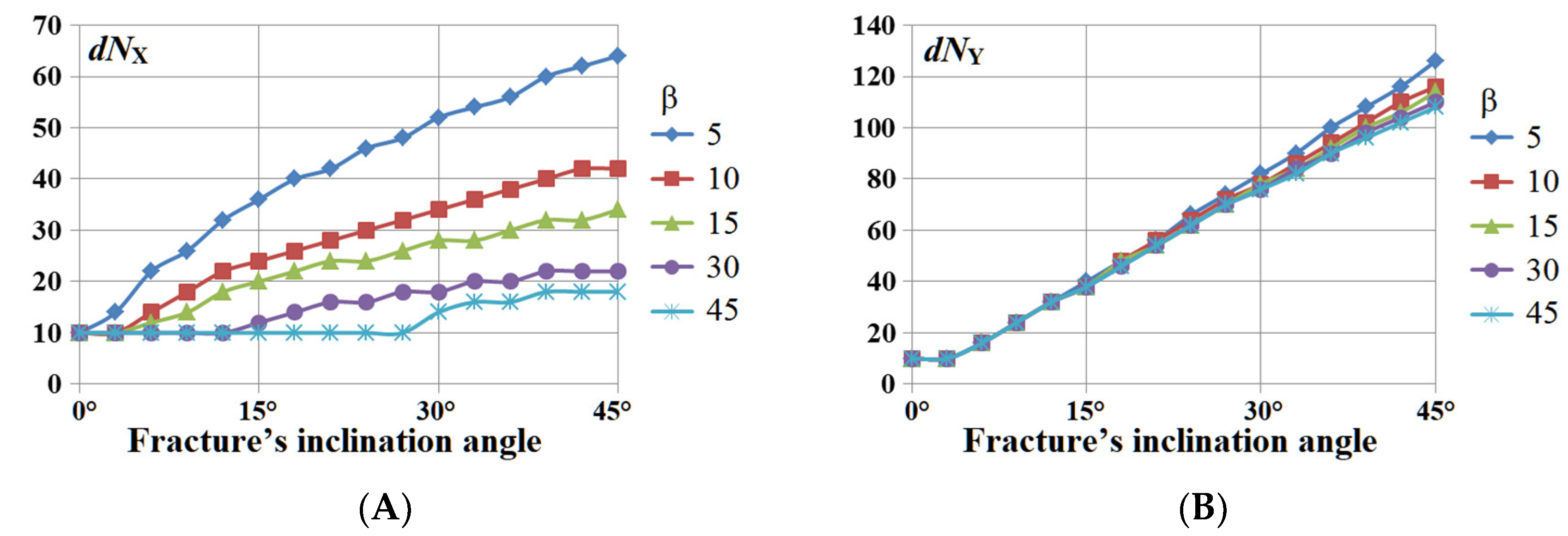

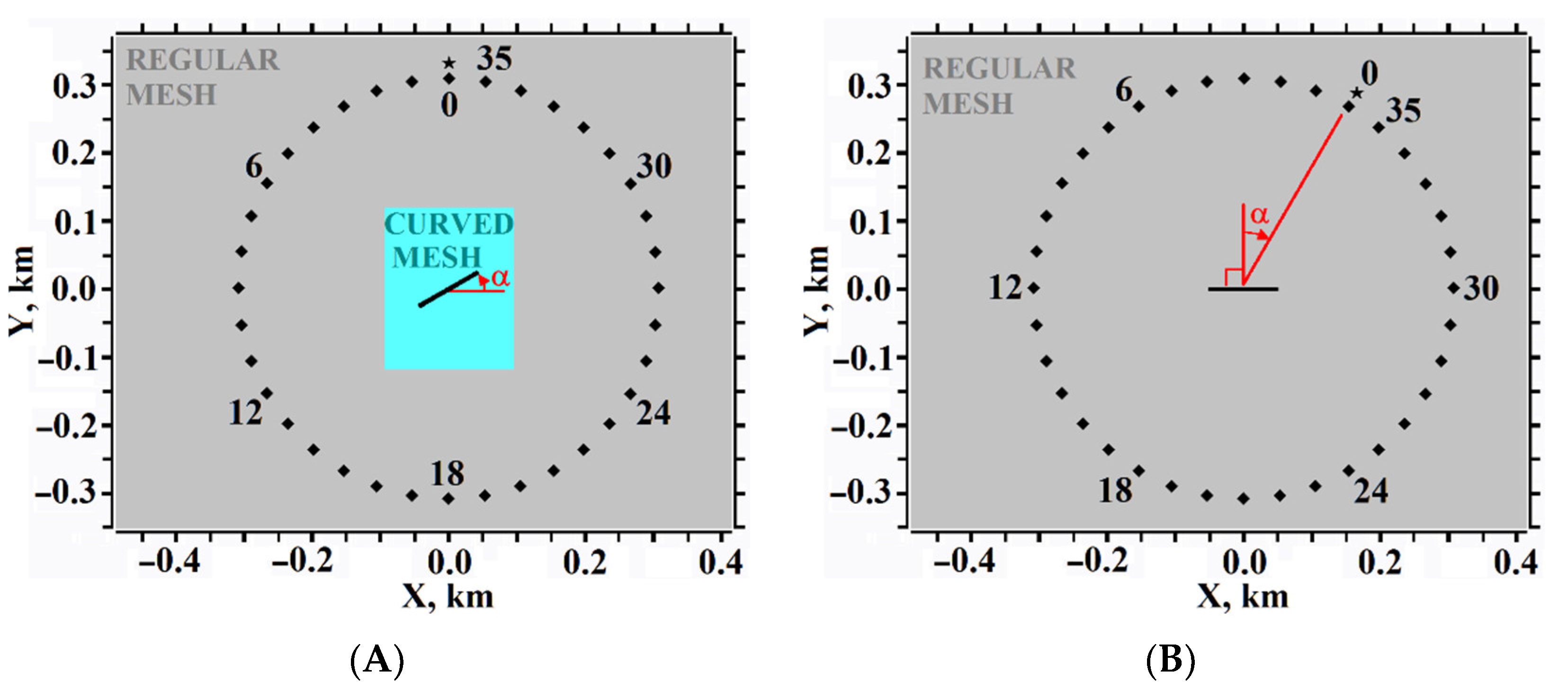
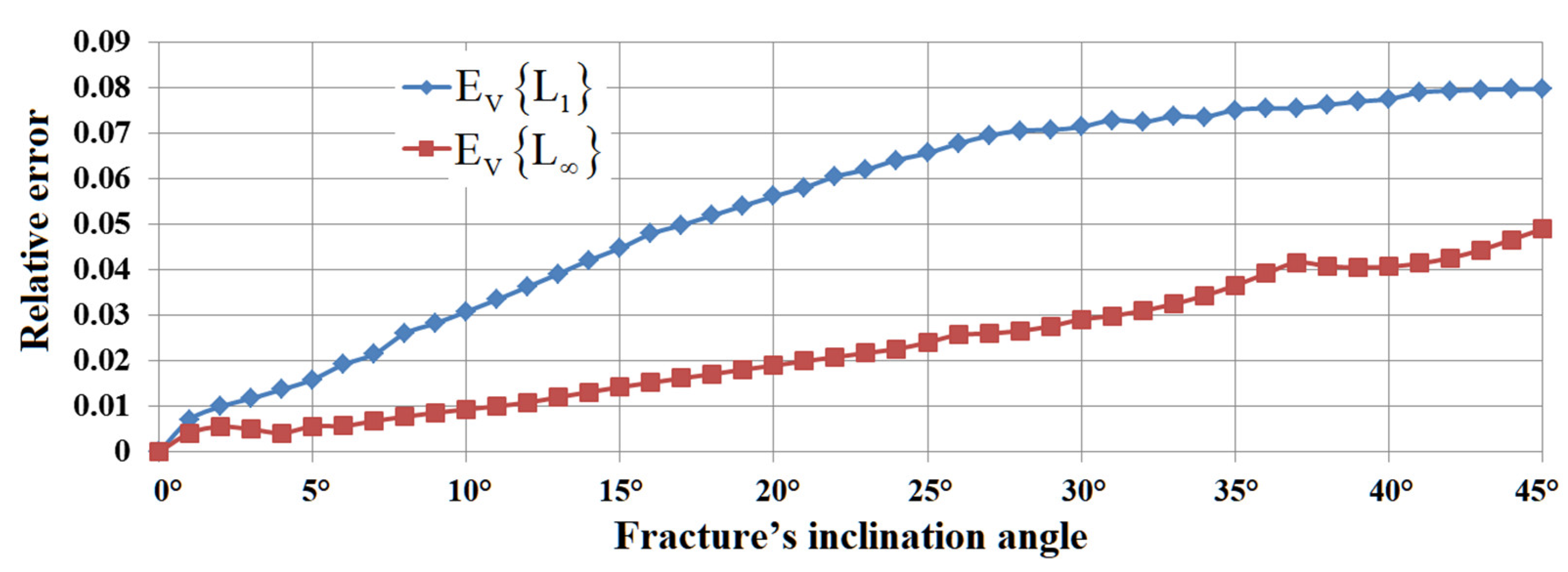
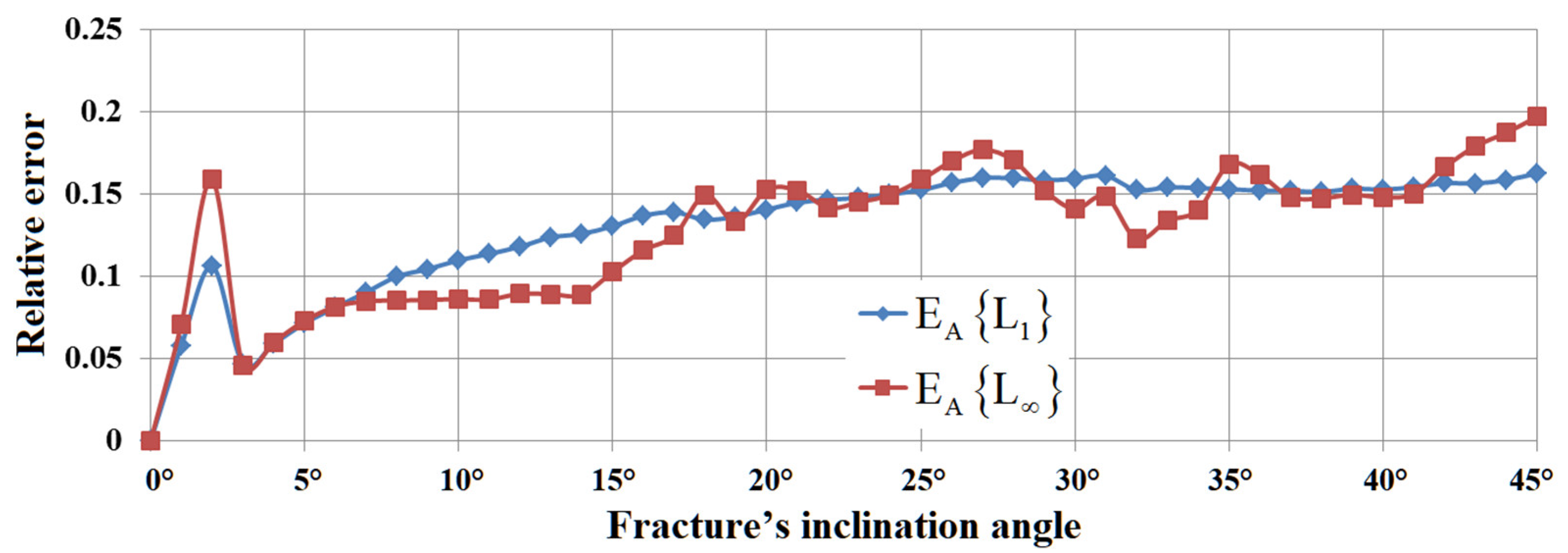
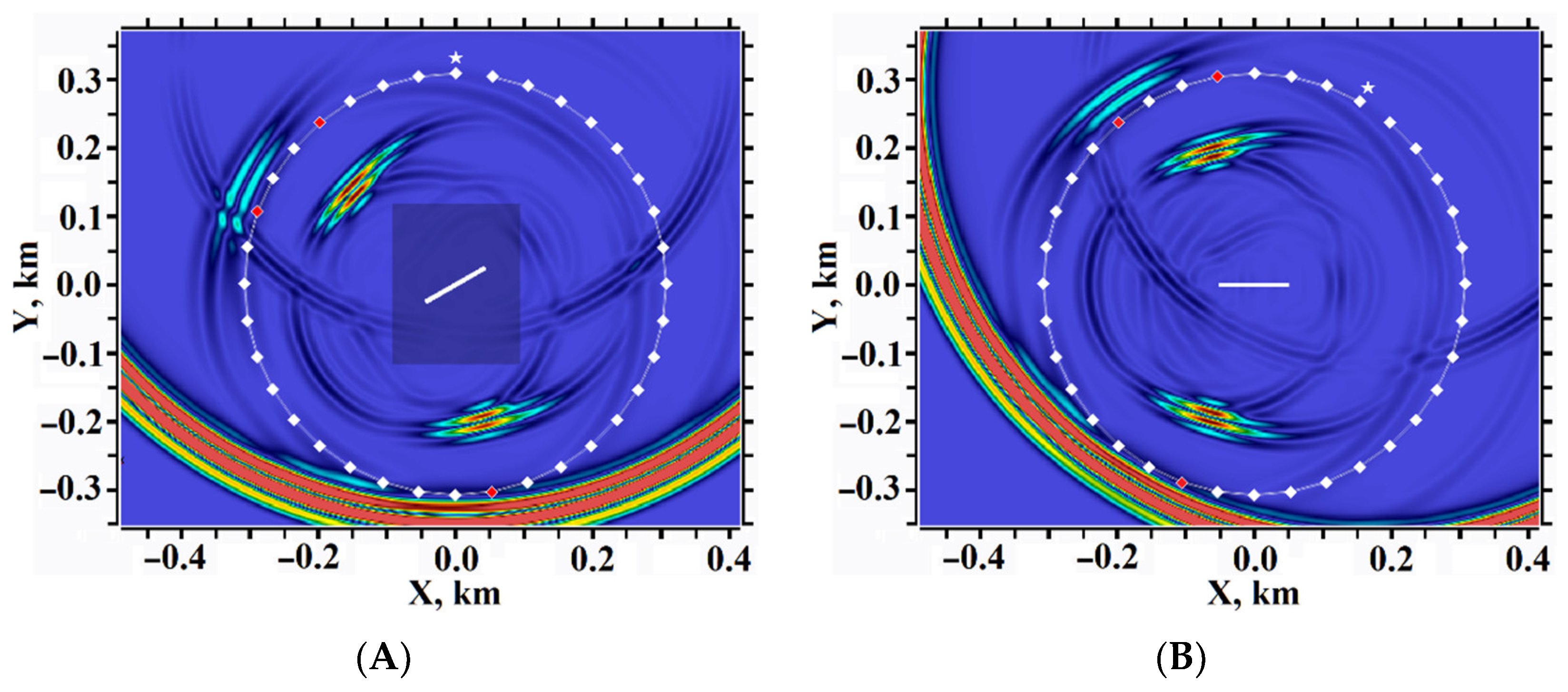



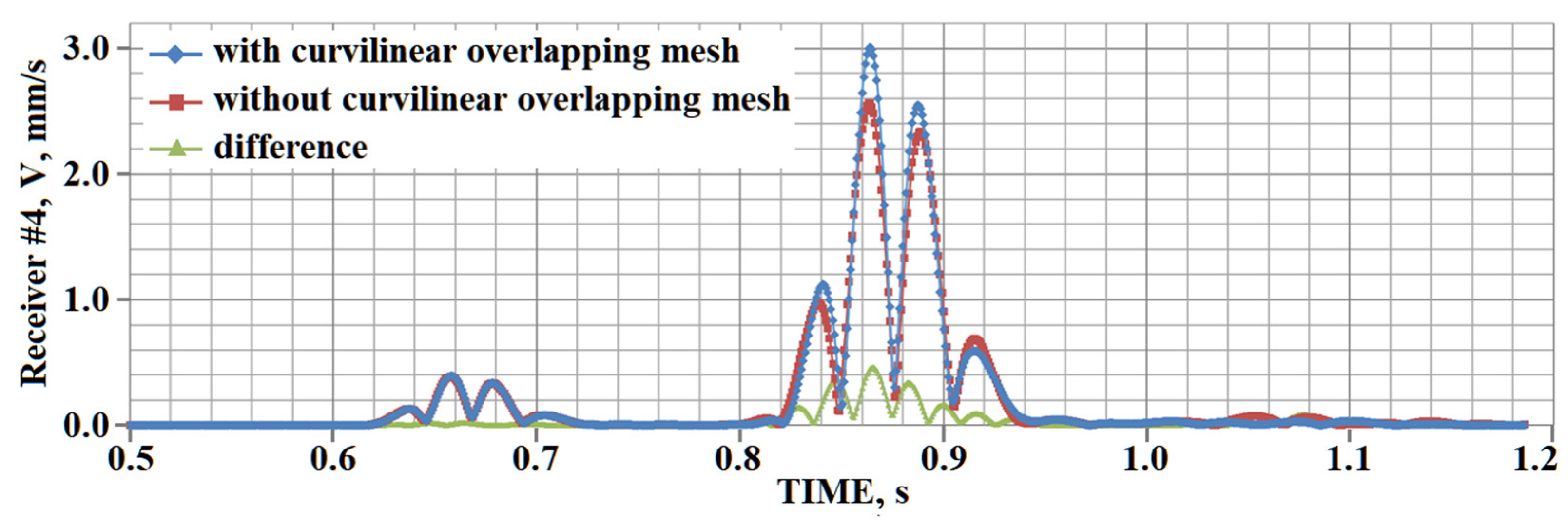












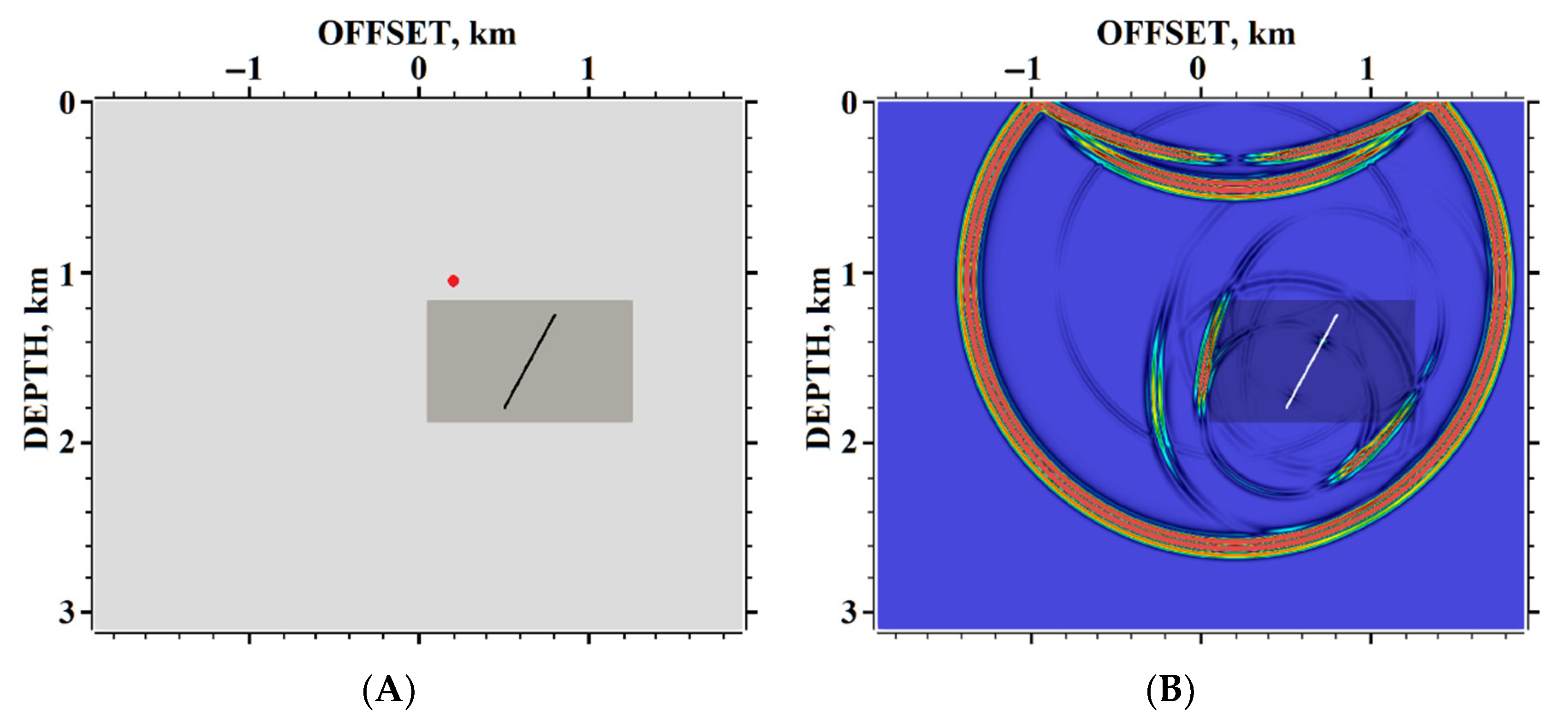
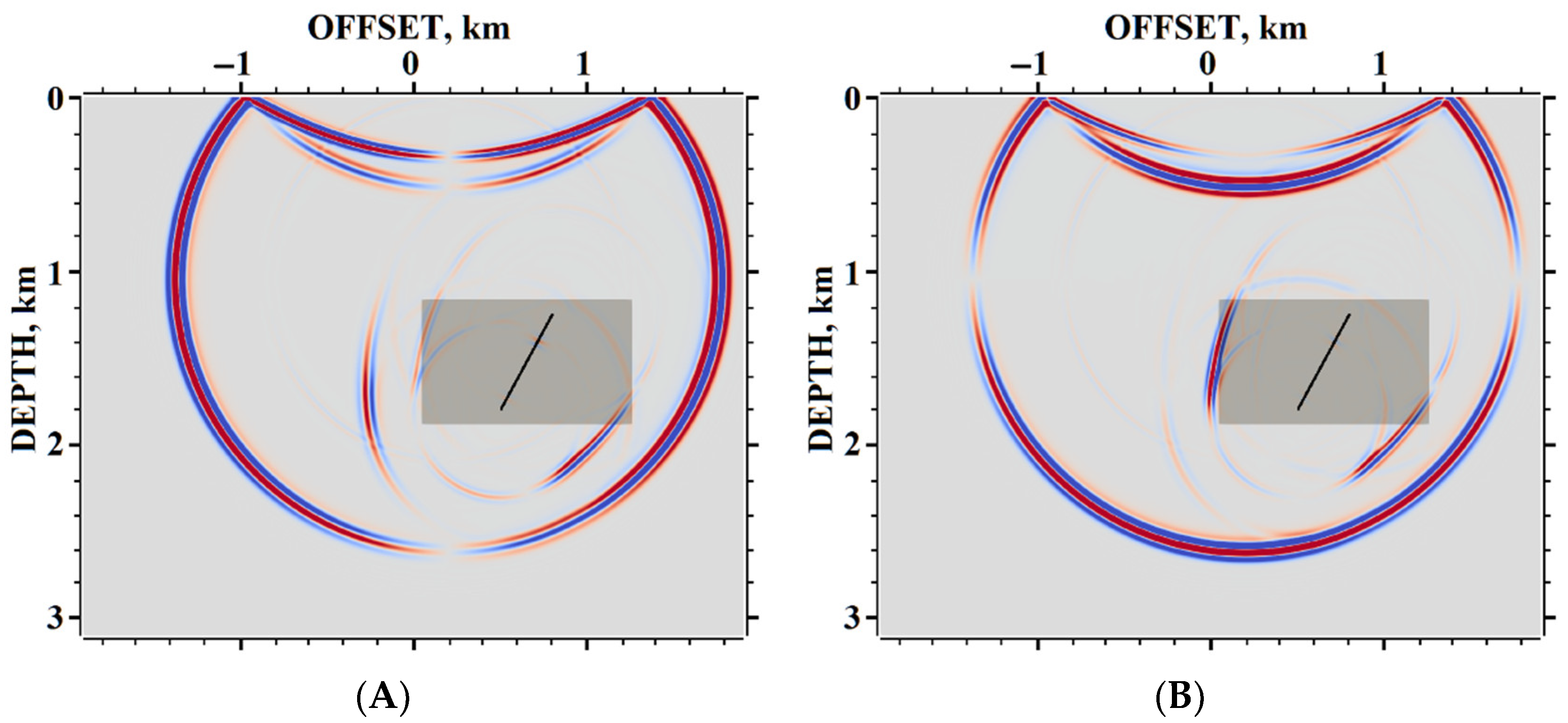

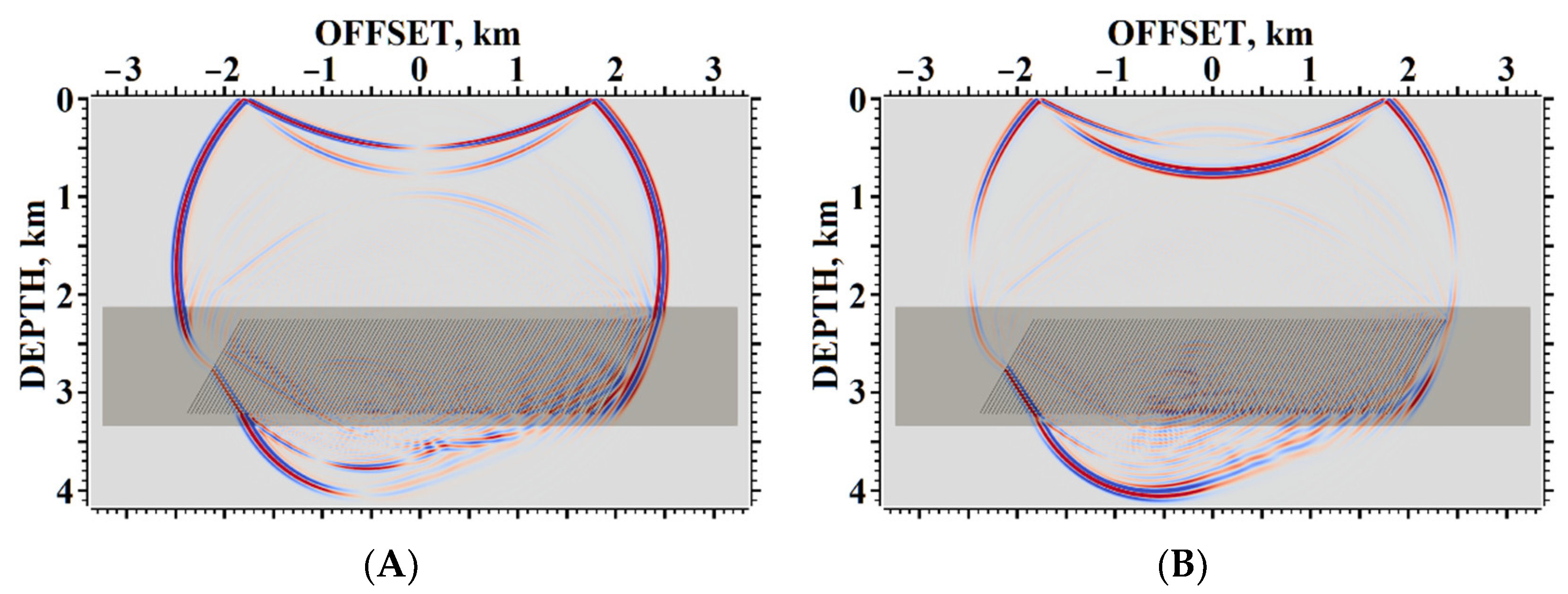




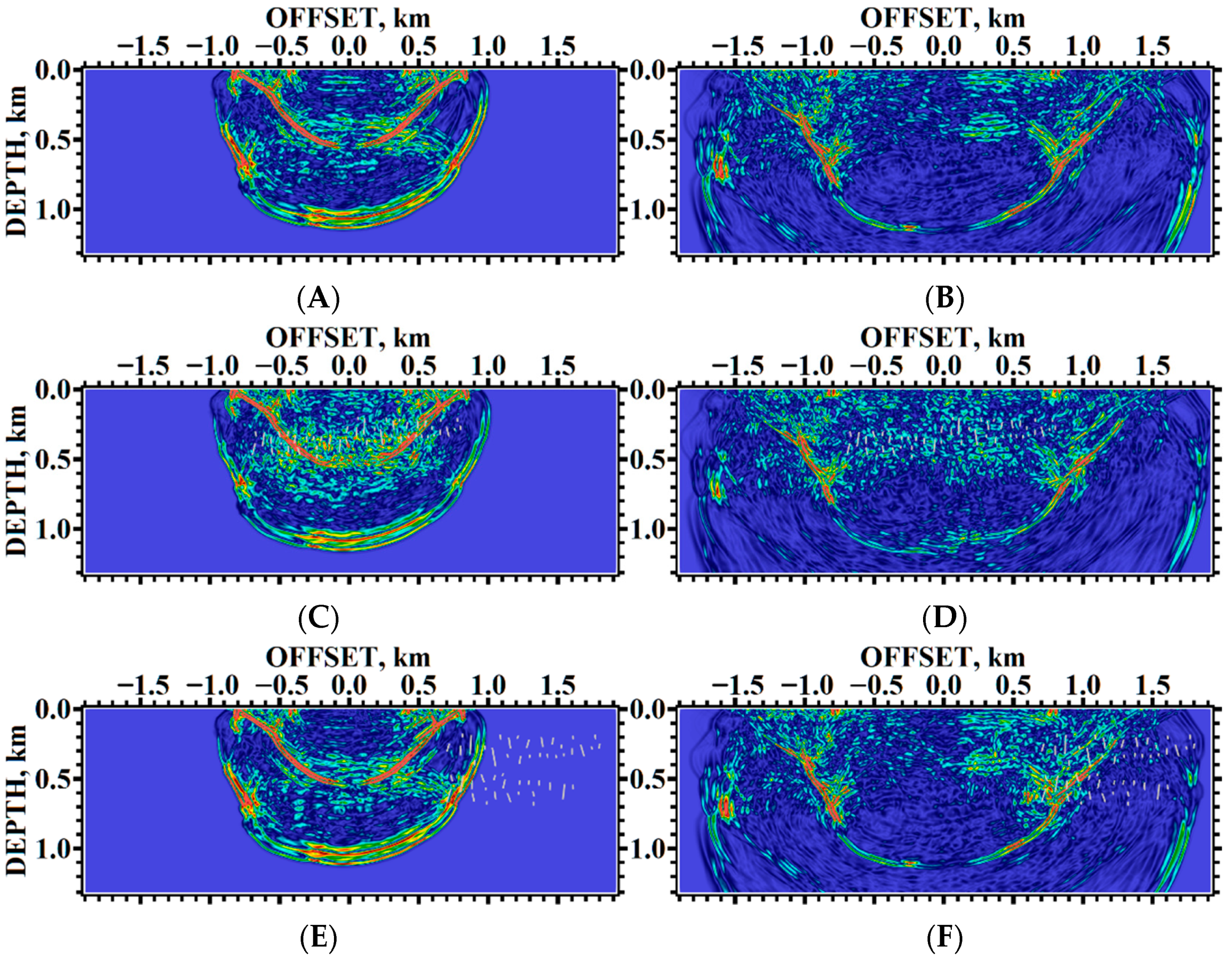

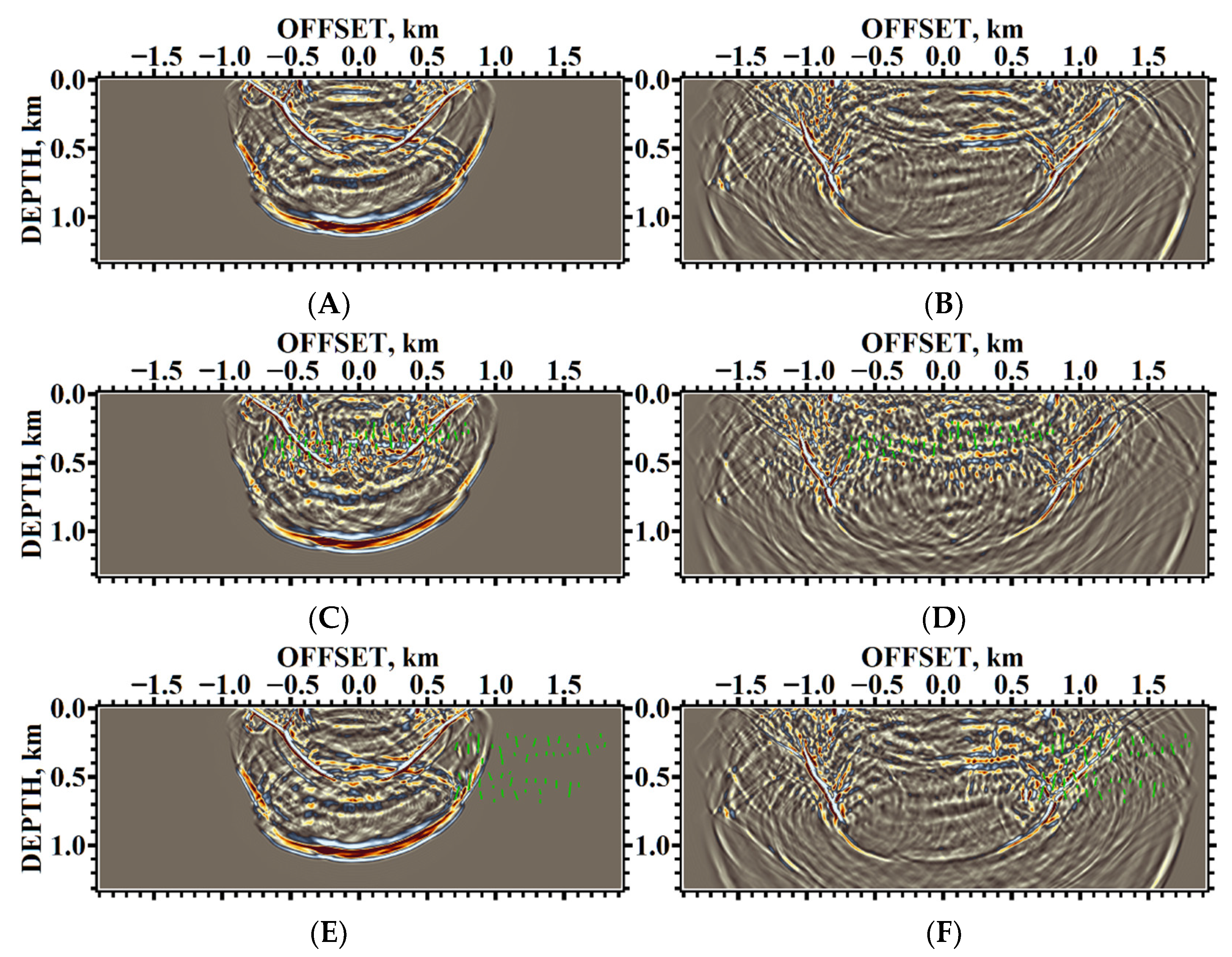



Publisher’s Note: MDPI stays neutral with regard to jurisdictional claims in published maps and institutional affiliations. |
© 2022 by the authors. Licensee MDPI, Basel, Switzerland. This article is an open access article distributed under the terms and conditions of the Creative Commons Attribution (CC BY) license (https://creativecommons.org/licenses/by/4.0/).
Share and Cite
Khokhlov, N.I.; Favorskaya, A.; Furgailo, V. Grid-Characteristic Method on Overlapping Curvilinear Meshes for Modeling Elastic Waves Scattering on Geological Fractures. Minerals 2022, 12, 1597. https://doi.org/10.3390/min12121597
Khokhlov NI, Favorskaya A, Furgailo V. Grid-Characteristic Method on Overlapping Curvilinear Meshes for Modeling Elastic Waves Scattering on Geological Fractures. Minerals. 2022; 12(12):1597. https://doi.org/10.3390/min12121597
Chicago/Turabian StyleKhokhlov, Nikolay I., Alena Favorskaya, and Vladislav Furgailo. 2022. "Grid-Characteristic Method on Overlapping Curvilinear Meshes for Modeling Elastic Waves Scattering on Geological Fractures" Minerals 12, no. 12: 1597. https://doi.org/10.3390/min12121597
APA StyleKhokhlov, N. I., Favorskaya, A., & Furgailo, V. (2022). Grid-Characteristic Method on Overlapping Curvilinear Meshes for Modeling Elastic Waves Scattering on Geological Fractures. Minerals, 12(12), 1597. https://doi.org/10.3390/min12121597






